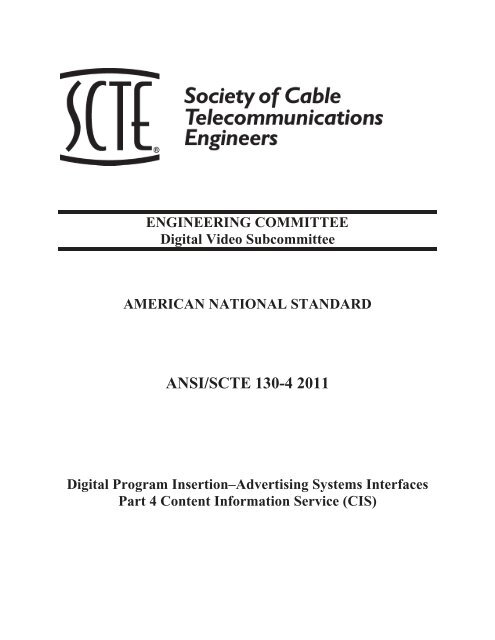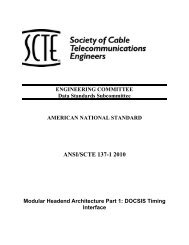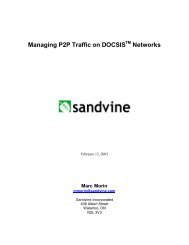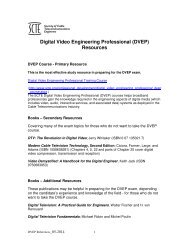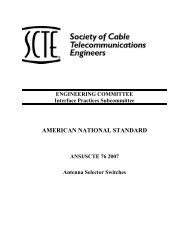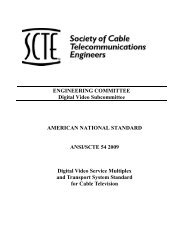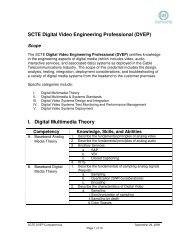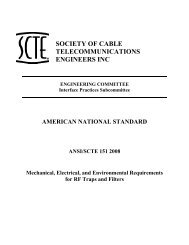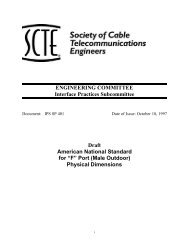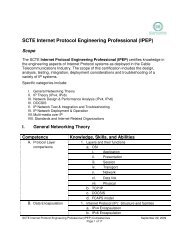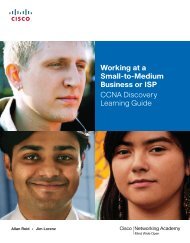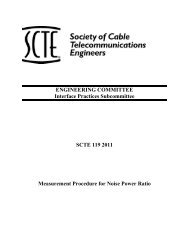ANSI/SCTE 130-4 2011
ANSI/SCTE 130-4 2011
ANSI/SCTE 130-4 2011
Create successful ePaper yourself
Turn your PDF publications into a flip-book with our unique Google optimized e-Paper software.
ENGINEERING COMMITTEEDigital Video SubcommitteeAMERICAN NATIONAL STANDARD<strong>ANSI</strong>/<strong>SCTE</strong> <strong>130</strong>-4 <strong>2011</strong>Digital Program Insertion–Advertising Systems InterfacesPart 4 Content Information Service (CIS)
NOTICEThe Society of Cable Telecommunications Engineers (<strong>SCTE</strong>) Standards are intended to serve thepublic interest by providing specifications, test methods and procedures that promote uniformityof product, interchangeability and ultimately the long term reliability of broadbandcommunications facilities. These documents shall not in any way preclude any member or nonmemberof <strong>SCTE</strong> from manufacturing or selling products not conforming to such documents, norshall the existence of such standards preclude their voluntary use by those other than <strong>SCTE</strong>members, whether used domestically or internationally.<strong>SCTE</strong> assumes no obligations or liability whatsoever to any party who may adopt the Standards.Such adopting party assumes all risks associated with adoption of these Standards, and acceptsfull responsibility for any damage and/or claims arising from the adoption of such Standards.Attention is called to the possibility that implementation of this standard may require the use ofsubject matter covered by patent rights. By publication of this standard, no position is taken withrespect to the existence or validity of any patent rights in connection therewith. <strong>SCTE</strong> shall notbe responsible for identifying patents for which a license may be required or for conductinginquiries into the legal validity or scope of those patents that are brought to its attention.Patent holders who believe that they hold patents which are essential to the implementation ofthis standard have been requested to provide information about those patents and any relatedlicensing terms and conditions. Any such declarations made before or after publication of thisdocument are available on the <strong>SCTE</strong> web site at http://www.scte.org.All Rights Reserved© Society of Cable Telecommunications Engineers, Inc. <strong>2011</strong>140 Philips RoadExton, PA 19341i
TABLE OF CONTENTS1.0 SCOPE ........................................................................................................................................................... 12.0 REFERENCES .............................................................................................................................................. 12.1 NORMATIVE REFERENCES ........................................................................................................................... 12.1.1 Normative Reference Acquisition .......................................................................................................... 13.0 COMPLIANCE NOTATION....................................................................................................................... 24.0 DEFINITIONS AND ACRONYMS ............................................................................................................ 25.0 ABBREVIATIONS ....................................................................................................................................... 26.0 CONTENT INFORMATION SERVICE OVERVIEW (INFORMATIVE) ............................................ 37.0 NOTATIONAL CONVENTIONS ............................................................................................................... 47.1 NORMATIVE XML SCHEMA ........................................................................................................................ 47.2 DOCUMENT CONVENTIONS ......................................................................................................................... 48.0 PROCESSING CONVENTIONS ................................................................................................................ 48.1 UNKNOWN/UNRECOGNIZED/UNSUPPORTED XML ELEMENTS AND ATTRIBUTES ........................................ 49.0 XML NAMESPACES ................................................................................................................................... 510.0 DATA MODEL AND QUERY SUPPORT ................................................................................................. 611.0 CIS MESSAGES ........................................................................................................................................... 611.1 @VERSION ATTRIBUTE ............................................................................................................................... 711.2 REQUEST BASE MESSAGE ........................................................................................................................... 711.3 RESPONSE BASE MESSAGE .......................................................................................................................... 711.4 NOTIFICATION BASE MESSAGE ................................................................................................................... 811.5 ACKNOWLEDGEMENT BASE MESSAGE ........................................................................................................ 811.6 MESSAGES REQUIRING NOTIFICATION REGISTRATION ................................................................................ 811.7 CIS MESSAGE EXCHANGE ........................................................................................................................... 911.8 CISLISTSUPPORTEDFEATURESREQUEST AND RESPONSE ............................................................................ 911.8.1 CISListSupportedFeaturesRequest Message ..................................................................................... 911.8.2 CISListSupportedFeaturesResponse Message ................................................................................1011.9 CISLISTQUALIFIERSREQUEST AND RESPONSE MESSAGES ........................................................................ 1211.10 CISLISTNOTIFICATIONREGISTRATIONREQUEST AND RESPONSE .............................................................. 1511.10.1 CISListNotificationRegistrationRequest Message ..........................................................................1511.10.2 CISListNotificationRegistrationResponse Message ........................................................................1611.11 CISNOTIFICATIONREGISTRATIONREQUEST AND RESPONSE ..................................................................... 1811.11.1 CISNotificationRegistrationRequest Message ................................................................................1811.11.2 CISNotificationRegistrationResponse Message ..............................................................................<strong>2011</strong>.12 CISNOTIFICATION AND ACKNOWLEDGEMENT .......................................................................................... 2111.12.1 CISNotification Message .................................................................................................................2111.12.2 CISNotificationAcknowledgement Message ....................................................................................2311.13 CISCREATECURSORREQUEST AND RESPONSE .......................................................................................... 2411.13.1 CISCreateCursorRequest Message ................................................................................................. 2411.13.2 CISCreateCursorResponse Message...............................................................................................2511.14 CISCANCELCURSORREQUEST AND RESPONSE .......................................................................................... 2711.14.1 CISCancelCursorRequest Message ................................................................................................2711.14.2 CISCancelCursorResponse Message ..............................................................................................2811.15 CISQUERYREQUEST AND RESPONSE......................................................................................................... 2911.15.1 CISQueryRequest Message .............................................................................................................3011.15.2 CISQueryResponse Message ...........................................................................................................3111.16 CISNOTIFICATIONDEREGISTERREQUEST AND RESPONSE ......................................................................... 33ii
11.16.1 CISNotificationDeregisterRequest Message ...................................................................................3311.16.2 CISNotificationDeregisterResponse Message. ................................................................................3411.17 CISDEREGISTRATIONNOTIFICATION AND ACKNOWLEDGEMENT .............................................................. 3611.17.1 CISDeregistrationNotification Message .........................................................................................3611.17.2 CISDeregistrationAcknowledgement Message ...............................................................................3811.18 SERVICE CHECK SUPPORT ......................................................................................................................... 3911.19 SERVICE STATUS SUPPORT ........................................................................................................................ 39A. APPENDIX A CABLELABS VOD METADATA 1.1 DATA MODEL CONNECTOR(NORMATIVE) .........................................................................................................................................................41A.1 NORMATIVE REFERENCES ......................................................................................................................... 41A.2 SERVICEDATAMODEL URL ...................................................................................................................... 41A.3 UNIQUE QUALIFIERS ................................................................................................................................. 41A.4 QUERY AND RESPONSE.............................................................................................................................. 42A.5 QUERY SEMANTICS ................................................................................................................................... 42B. APPENDIX B CABLELABS VOD METADATA 3.0 DATA MODEL CONNECTOR(NORMATIVE) .........................................................................................................................................................45B.1 XML NAMESPACES ................................................................................................................................... 45B.2 NORMATIVE REFERENCES ......................................................................................................................... 45B.3 SERVICEDATAMODEL URL ...................................................................................................................... 45B.4 UNIQUE QUALIFIERS ................................................................................................................................. 46B.5 QUERY AND RESPONSE.............................................................................................................................. 46B.6 QUERY SEMANTICS ................................................................................................................................... 46C. APPENDIX C CONTENT FORECASTING DATA MODEL CONNECTOR (NORMATIVE) ........49C.1 SERVICEDATAMODEL URL ...................................................................................................................... 49C.2 UNIQUE QUALIFIERS ................................................................................................................................. 49C.3 QUALIFIERS ............................................................................................................................................... 49C.4 QUERY AND RESPONSE.............................................................................................................................. 50C.5 QUERY SEMANTICS ................................................................................................................................... 50C.6 CONTENTBASICQUERYRESULT XML SCHEMA ......................................................................................... 51C.7 CONTENTBASICQUERYRESULT ELEMENT DETAILS .................................................................................. 51C.7.1 ContentBundle .....................................................................................................................................51C.7.2 DataModelContent...............................................................................................................................53C.7.3 Region..................................................................................................................................................53C.7.4 Owner ..................................................................................................................................................54D. APPENDIX D WSDL (NORMATIVE) .....................................................................................................55E. APPENDIX E GENERIC DATA MODEL CONNECTOR (INFORMATIVE) ...................................55F. APPENDIX F LIST QUALIFIERS REQUEST AND RESPONSE EXAMPLE (INFORMATIVE) ..56G. APPENDIX G QUERY REQUEST AND RESPONSE (INFORMATIVE)...........................................57iii
LIST OF FIGURESFigure 1 - CIS Content Storage 3Figure 2 - CIS Forecasting 4Figure 3 - CIS Message Exchange 9Figure 4 – CISListSupportedFeaturesRequest XML Schema 10Figure 5 – CISListSupportedFeaturesResponse XML Schema 11Figure 6 – CISListQualifiersRequest XML Schema 13Figure 7 – CISListQualifiersResponse XML Schema 14Figure 8 - CISListNotificationRegistrationRequest XML Schema 16Figure 9 - CISListNotificationRegistrationResponse XML Schema 17Figure 10 – CISNotificationRegistrationRequest XML Schema 19Figure 11 – CISNotificationRegistrationResponse XML Schema 21Figure 12 – CISNotification XML Schema 22Figure 13 - CISNotificationAcknowledgement XML Schema 23Figure 14 - CreateCursorRequest XML Schema 25Figure 15 - CreateCursorResponse XML Schema 26Figure 16 - CISCancelCursorRequest XML Schema 28Figure 17 - CISCancelCursorResponse XML Schema 29Figure 18 – CISQueryRequest XML Schema 31Figure 19 – CISQueryResponse XML Schema 32Figure 20 – CISNotificationDeregisterRequest XML Schema 34Figure 21 - CISNotificationDeregisterResponse XML Schema 35Figure 22 – CISDeregistrationNotification XML Schema 37Figure 23 – CISDeregistrationAcknowledgement XML Schema 38Figure 24 - VOD Metadata 1.1 Data Model Connector XML Schema 43Figure 25 – Content Metadata 3.0 Data Model Connector XML Schema 48Figure 26 - Content Forecasting Data Model Connector XML Schema 51Figure 27 - ContentBundle XML Schema 52Figure 28 – DataModelContent XML Schema 53Figure 29 - Region XML Schema 54Figure 30 - Owner XML SChema 54LIST OF TABLESTable 1: Normative References 1Table 2: Compliance Notice 2iv
Table 3: XML Namespace Declarations 5Table 4: CIS Top Level Messages 7Table 5: ListSupportedFeatures core:Callout @message values 12Table 6: CISNotificationRegistrationResponse core:Callout @message values 20Table 7: VOD Metadata 1.1 Data Model Connector Normative References 41Table 8: gis:ServiceDataModel Definition for VOD Metadata 1.1 Data Model Connector 41Table 9: @expandOutput Options for the VOD Metadata 1.1 Data Model Connector 43Table 10: Cablelabs VOD Metadata 3.0 Data Model Connector Namespaces 45Table 11: CableLabs VOD Metadata 3.0 Data Model Connector Normative References 45Table 12: gisServiceDataModel Definition for VOD 3.0 Data Model Connector 45Table 13: @expandOutput choices for VOD 3.0 Data Model Connector 47Table 14: gis:ServiceDataModel Definition for Content Forecasting Data Model Connector 49Table 15: Content Forecasting Data Model Connector Qualifier Descriptions 50v
Digital Program Insertion—Advertising Systems InterfacesPart 4—Content Information Service (CIS)1.0 SCOPEThis document, <strong>SCTE</strong> <strong>130</strong> Part 4, describes the Digital Program Insertion AdvertisingSystems Interfaces‘ Content Information Service (CIS) messaging and data typespecification using XML, XML Namespaces, and XML Schema.2.0 REFERENCES2.1 Normative ReferencesThe following standards contain provisions that, through reference in this text,constitute provisions of this standard. At the time of publication, the editionsindicated were valid. All standards are subject to revision, and parties to agreementsbased on this standard are encouraged to investigate the possibility of applying themost recent edition of the standards indicated below.[<strong>SCTE</strong><strong>130</strong>-1][<strong>SCTE</strong><strong>130</strong>-2]<strong>SCTE</strong> <strong>130</strong>-1 <strong>2011</strong>: Digital Program Insertion—AdvertisingSystems Interfaces Part 1—Overview<strong>SCTE</strong> <strong>130</strong>-2 2008a: Digital Program Insertion—AdvertisingSystems Interfaces Part 2 - Core Data Elements[<strong>SCTE</strong><strong>130</strong>-7] <strong>ANSI</strong>/<strong>SCTE</strong> <strong>130</strong>-7 2009: Digital Program Insertion –Advertising Systems Interface Part 7 – Message Transport[<strong>SCTE</strong><strong>130</strong>-8][W3C - XSD]<strong>SCTE</strong> <strong>130</strong>-8 <strong>2011</strong>: Digital Program Insertion – AdvertisingSystems Interfaces Part 8 – General Information ServiceXML Schema Part 1: Structures Second EditionTable 1: Normative ReferencesAll normative references found in any of the Table 1 references are included andapply to this document. See the individual specifications for additional information.2.1.1 Normative Reference Acquisition2.1.1.1 <strong>SCTE</strong> Standards: United States of AmericaSociety of Cable Telecommunications Engineers Inc., 140 Philips Road,Exton, PA 19341; Telephone 800-542-5040; Facsimile: 610-363-5898; E-mail: standards@scte.org; URL: http://www.scte.org.1
2.1.1.2 W3C Standards3.0 COMPLIANCE NOTATIONMIT, 32 Vassar Street, Room 32-G515, Cambridge, MA 02139, USA;Telephone: +1.617.258.5999; http://www.w3.org..―SHALL” This word or the adjective ―REQUIRED” means that the item is anabsolute requirement of this specification.―SHALL NOT” This phrase means that the item is an absolute prohibition of thisspecification.―SHOULD” This word or the adjective ―RECOMMENDED” means that there mayexist valid reasons in particular circumstances to ignore this item, butthe full implications should be understood and the case carefullyweighted before choosing a different course.―SHOULD NOT” This phrase means that there may exist valid reasons in particularcircumstances when the listed behavior is acceptable or even useful,but the full implications should be understood and the case carefullyweighed before implementing any behavior described with this label.―MAY” This word or the adjective ―OPTIONAL” means that this item is trulyoptional. One vendor may choose to include the item because aparticular marketplace requires it or because it enhances the product,for example; another vendor may omit the same item.Table 2: Compliance Notice4.0 DEFINITIONS AND ACRONYMSThroughout this standard the terms below have specific meanings. Because some of theterms are defined in other <strong>SCTE</strong> documents having very specific technical meanings, thereader is referred to the original source for their definition. For terms defined by thisstandard, brief definitions are given below.All [<strong>SCTE</strong><strong>130</strong>-2], [<strong>SCTE</strong><strong>130</strong>-7] and [<strong>SCTE</strong><strong>130</strong>-8] definitions are included herein. See[<strong>SCTE</strong><strong>130</strong>-2], [<strong>SCTE</strong><strong>130</strong>-7] and [<strong>SCTE</strong><strong>130</strong>-8] for additional information5.0 ABBREVIATIONSAll [<strong>SCTE</strong><strong>130</strong>-2], [<strong>SCTE</strong><strong>130</strong>-7] and [<strong>SCTE</strong><strong>130</strong>-8] definitions are included herein. See[<strong>SCTE</strong> <strong>130</strong> -2], [<strong>SCTE</strong><strong>130</strong>-7] and [<strong>SCTE</strong><strong>130</strong>-8] for additional information. This interfaceis an advertising service of [<strong>SCTE</strong><strong>130</strong>-8] and makes references accordingly.CIS – Content Information Service2
6.0 CONTENT INFORMATION SERVICE OVERVIEW (INFORMATIVE)A CIS provides asset metadata query and notification services, including media availabilityif known, to service consumers. Using the interfaces defined in this specification, serviceconsumers may retrieve detailed information about assets referenced by a CIS.There are multiple use cases supported by this standard. A straightforward example is aVOD or linear delivery system with stored ad content. The advertising system queries thedelivery system‘s available storage using the CIS interface to insure ad copy is availablefor placement.A second CIS use is to inform an advertising system of available entertainment content ormetadata for creating and directing campaigns. In this case, an advertising system mayadjust dynamically to the arrival of new entertainment content, or metadata.Figure 1 shows the location and possible clients of a CIS representing stored ad orentertainment content.Figure 1 - CIS Content StorageA third use case, referred to as ‗forecasting‘ herein, has the advertising system or campaignmanager include a CIS in order to provide information relative to ad and/or entertainmentassets required by clients at the present time, or at some future time. Content informationreturned by a forecasting service does not necessarily reflect stored ad copy, but ratherreflects current or upcoming ad and/or entertainment copy needs. The client of such aforecasting service could use the retrieved information to obtain, transcode and/orotherwise prepare ad and/or entertainment assets for current or future needs.Note that all the use cases outlined above may exist in the same system. A delivery systemmay access a forecasting service to access and prepare ad copy. When the ad copy isavailable for placement, the delivery system may update or notify the advertising systemthat the available ad copy has changed and the advertising system may then begin toinclude the new advertisements in advertising decisions.3
Figure 2 below illustrates this use of dual CIS services.Figure 2 - CIS ForecastingPart 4 facilitates the expression of CIS supported data models through the use of XMLsubstitution groups. The inclusion of multiple data models is accomplished using a‗connector schema‘. Connector schemas conform to <strong>SCTE</strong> <strong>130</strong> Part 8 by extending thedefinition of the gis:BasicQueryResultAbstract, using XML substitution groups. Thesesubstitution groups may include references to additional namespaces and/or XMLelements.See Appendix E for and explanation of the generic format of a connector schema. Also seeAppendices A, B and C for optional normative connectors defined by this standard.7.0 NOTATIONAL CONVENTIONS7.1 Normative XML Schema<strong>SCTE</strong> <strong>130</strong> Part 4 employs the same notational conventions as [<strong>SCTE</strong><strong>130</strong>-8]. Refer to[<strong>SCTE</strong><strong>130</strong>-8] for an explanation of notational conventions.7.2 Document Conventions<strong>SCTE</strong> <strong>130</strong> Part 4 employs the same document conventions as [<strong>SCTE</strong><strong>130</strong>-8]. Refer to[<strong>SCTE</strong><strong>130</strong>-8] for an explanation of document conventions.8.0 PROCESSING CONVENTIONS8.1 Unknown/Unrecognized/Unsupported XML Elements and AttributesSee [<strong>SCTE</strong><strong>130</strong>-2] for information.4
9.0 XML NAMESPACESThis specification uses the ‗cis‘ prefix, as described in Table 3, for the interface associatedwith the specific XML namespace URI that shall be used by all implementations. Table 3lists the prefix, the corresponding namespace, and a description of the definingspecification used herein.Prefix Namespace Descriptioncore http://www.scte.org/schemas/<strong>130</strong>-2/2008a/core See [<strong>SCTE</strong><strong>130</strong>-2]gis http://www.scte.org/schemas/<strong>130</strong>-8/<strong>2011</strong>/gis See [<strong>SCTE</strong><strong>130</strong>-8]cis http://www.scte.org/schemas/<strong>130</strong>-4/<strong>2011</strong>/cis <strong>SCTE</strong> <strong>130</strong> Part 4query http://www.scte.org/schemas/<strong>130</strong>-4/<strong>2011</strong>/cis/query <strong>SCTE</strong> <strong>130</strong> Part 4wsdl http://www.scte.org/wsdl/<strong>130</strong>-4/<strong>2011</strong>/cis <strong>SCTE</strong> <strong>130</strong> Part 4xsd http://www.w3.org/2001/XMLSchema See [W3C-XSD]Table 3: XML Namespace DeclarationsUnless otherwise stated, all references to XML elements illustrated in this document arefrom the ‗cis‘ namespace. Elements from other namespaces will be prefixed with the nameof the external namespace, e.g. .5
10.0 DATA MODEL AND QUERY SUPPORTFor query and response messages limited to basic query support, CIS implementationsshall support the exchange of name/value pairs, referred to as qualifiers. See [<strong>SCTE</strong><strong>130</strong>-8].Additionally, a CIS may support any number of external data models and an appropriateconnector schema should be defined for each supported data model.CIS implementations are not required to support any specific data model. All data modelsand connector schemas described herein are optional. CIS implementations choosing tosupport one or more data models described in Appendices A, B or C, shall implement theconnector schema as described in the respective normative section.11.0 CIS MESSAGESThis specification includes a query and a notification model for CIS to endpointmessaging. The model includes associated notification management functions such asregistration, deregistration and active registration listing.The following topics are covered by [<strong>SCTE</strong><strong>130</strong>-8]. Message format XML message carriage Transport mechanisms Message error handlingThis specification considers all aspects defined therein to be normative and applicableherein. See [<strong>SCTE</strong><strong>130</strong>-2] and [<strong>SCTE</strong><strong>130</strong>-8] for additional information.The CIS message interface shall include the messages defined in [<strong>SCTE</strong><strong>130</strong>-2]. Table 4identifies additional <strong>SCTE</strong> <strong>130</strong> Part 4 CIS specific messages.MessageCISListSupportedFeaturesRequestCISListSupportedFeaturesResponseCISListQualifiersRequestCISListQualifiersResponseCISListNotificationRegistrationRequestCISListNotificationRegistrationResponseCISNotificationRegistrationRequestCISNotificationRegistrationResponseDescriptionRequest to retrieve a list of CIS supportedfeaturesResponse to CISListSupportedFeaturesRequestRequest to list basic query qualifier informationResponse to CISListQualifiersRequestRequest to list existing registrationsResponse toCISListNotificationRegistrationRequestRegistration request for content notificationResponse to CISNotificationRegistrationRequest6
CISNotificationCISNotificationAcknowledgementCISCreateCursorRequestCISCreateCursorResponseCISCancelCursorRequestCISCancelCursorResponseCISQueryRequestCISQueryResponseCISNotificationDeregisterRequestCISNotificationDeregisterResponseCISDeregistrationNotificationCISDeregistrationAcknowledgement11.1 @version AttributeNotification message indicating asset statuschangeResponse to CISNotificationRequest to create a cursorResponse to CISCreateCursorRequestRequest to cancel an existing cursorResponse to CISCancelCursorRequestRequest to acquire records from the CISResponse to CISQueryRequestRequest to de-register a previously acceptedregistrationResponse to CISNotificationDeregisterRequestDeregistration notificationDeregistration notification acknowledgementTable 4: CIS Top Level MessagesFor all <strong>SCTE</strong> <strong>130</strong> Part 4 messages defined herein (i.e., those messages prefix with thestring ―CIS”), the @version attribute shall be set to the value ―2.0” for thisdocument‘s revision. For messages defined by the core namespace, for examplecore:ServiceStatus and core:ServiceNotification, their @version attribute shallcontain the value defined by the normatively referenced specification (e.g., ―1.1”).See [<strong>SCTE</strong><strong>130</strong>-2] for additional information.11.2 Request Base MessageAll CIS top level request messages are derived from the gis:Msg_RequestBaseTypeabstract base message type.11.2.1 Request Base Message AttributesAll request Base Message Attributes are consistent with those listed in[<strong>SCTE</strong><strong>130</strong>-8].11.2.2 Request Base Message ElementsAll Request Base Message Elements are consistent with those listed in[<strong>SCTE</strong><strong>130</strong>-8]11.3 Response Base MessageAll CIS top level response messages are derived from thegis:Msg_ResponseBaseType abstract base message type.11.3.1 Base Response Message Attributes7
All Response Base Message Attributes are consistent with those listed in[<strong>SCTE</strong><strong>130</strong>-8]11.3.2 Base Response Message ElementsAll Response Base Message Elements are consistent with those listed in[<strong>SCTE</strong><strong>130</strong>-8], except those elements listed below in this section.11.4 Notification Base MessageAll CIS top level not ton messages are derived from thegis:Msg_NotificationBaseType abstract base message type. See the [<strong>SCTE</strong><strong>130</strong>-8]document for details on the attributes and elements contained in this base message.11.4.1 Notification Base Message AttributesAll Notification Base Message Attributes are consistent with those listed in[<strong>SCTE</strong><strong>130</strong>-8].11.4.2 Notification Base Message ElementsAll Notification Base Message Elements are consistent with those listed in[<strong>SCTE</strong><strong>130</strong>-8].11.5 Acknowledgement Base MessageAll CIS top level noeeent messages are derived from thegis:Msg_AcknowledgementBaseType abstract base message type. See the[<strong>SCTE</strong><strong>130</strong>-8] document for details on the attributes and elements contained in thisbase message.11.5.1 Acknowledgement Base Message AttributesAll Acknowledgement Base Message Attributes are consistent with those listed in[<strong>SCTE</strong><strong>130</strong>-8].11.5.2 Acknowledgement Base Message ElementsAll Acknowledgement Base Message Elements are consistent with those listed in[<strong>SCTE</strong><strong>130</strong>-8].11.6 Messages Requiring Notification RegistrationRegistration is required for CISNotification, CISNotificationDeregisterRequest andCISDeregistrationNotification message exchanges. All other CIS messages do notrequire registration and may be sent at any time.8
11.7 CIS Message ExchangeThe following diagram illustrates a typical message exchange between a CIS clientand the CIS.Figure 3 - CIS Message ExchangeFigure 3 illustrates all of the message exchanges that are specific to the CIS. Thecore:ServiceCheck and core:ServiceStatus message exchanges are not depicted in thisillustration.11.8 CISListSupportedFeaturesRequest and ResponseThe CISListSupportedFeatures request and response messages allow clients to inquireabout CIS supported data models and advanced query languages.11.8.1 CISListSupportedFeaturesRequest MessageThe CISListSupportedFeatures request message allows a CIS client to inquireabout the data models and advanced query languages supported by a CIS.Advanced query language support is optional and thus, the response messagemay or may not contain information regarding advanced query languages.The XML schema definition for this message is illustrated in Figure 4.9
Figure 4 – CISListSupportedFeaturesRequest XML SchemaThis CIS interface adds only a single core:Ext to thegis:ListSupportedFeaturesRequestType defined by [<strong>SCTE</strong><strong>130</strong>-8]. See[<strong>SCTE</strong><strong>130</strong>-8] for additional information.11.8.2 CISListSupportedFeaturesResponse MessageA successful return status in the CISListSupportedFeaturesResponse messageindicates the message shall contain at a minimum the following elements.A single core:Callout element containing one or more core:Addresselement(s) supplying an endpoint for additional services as specified byTable 5. See [<strong>SCTE</strong><strong>130</strong>-2] and [<strong>SCTE</strong><strong>130</strong>-8] for additional information.One or more gis:ServiceDataModelProfile elements describing a datamodel supported by a CIS. CIS supported data models are outside thescope of this specification.10
The XML schema definition for this message is illustrated in Figure 5.Figure 5 – CISListSupportedFeaturesResponse XML Schema11
This CIS interface adds only a single core:ext to thegis:CISListSupportedFeaturesResponseType defined by [<strong>SCTE</strong><strong>130</strong>-8]. See[<strong>SCTE</strong><strong>130</strong>-8] for additional information.Table 5 contains the values for the @message attribute of the core:Calloutelement. Values for the @message attribute should be used exactly as defined inthis table.ValueDescriptionCISNotificationRegistrationRequest Destination endpoint for message.CISNotificationDeregisterRequest Destination endpoint for message.CISListQualifiersRequestDestination endpoint for message.CISListNotificationRegistrationRequest Destination endpoint for message.CISCreateCursorRequestDestination endpoint for message.CISCancelCursorRequestDestination endpoint for message.CISContentQueryRequestDestination endpoint for message.ServiceStatusNotificationDestination endpoint for message.…User defined address endpoint outsideof the scope of this specification. Thestring shall be prefixed with the text―private”.Table 5: ListSupportedFeatures core:Callout @message valuesAll message values listed in Table 5 and not present in theCISListSupportedFeaturesRequest message‘s core:Callout XML elementsequence shall be available through the default endpoint, if present. The defaultendpoint is identified by a core:Callout element not having the @messageattribute. See [<strong>SCTE</strong><strong>130</strong>-2] for additional information.11.9 CISListQualifiersRequest and Response MessagesThe CISListQualifiersRequest and CISListQualifiersResponse messages allow clientsto discover the asset metadata identifiers associated with a CIS implementation‘sservice data models, which may be queried with the basic query interface.11.9.1 CISListQualifiersRequest MessageThe CISListQualifiersRequest message allows a CIS consumer to inquire aboutthe qualifier names used by a service data model available for query using thebasic query interface.Figure 6 illustrates the CISListQualifiersRequest message‘s schema.12
Figure 6 – CISListQualifiersRequest XML SchemaThe CIS interface adds only a single core:Ext to the gis:ListQualifiersRequestTypedefined by [<strong>SCTE</strong><strong>130</strong>-8]. See [<strong>SCTE</strong><strong>130</strong>-8] for additional information.11.9.2 CISListQualifiersResponse MessageIf the CIS implementation supports the service data model specified in theCISListQualifiersRequest message‘s ServiceDataModel element, theCISListQualifiersResponse message shall contain, at a minimum, a singlegis:BasicQueryDataModelDescription element. See [<strong>SCTE</strong><strong>130</strong>-8] for additionalinformation on the gis:BasicQueryDataModelDescription element.If the CIS implementation does not support the service data model contained inthe CISListQualifiersRequest/ServiceDataModel element, no13
gis:BasicQueryDataModelDescription element shall be returned and theStatusCode element‘s @detailCode shall be set to core:ResourceNotFound.The XML schema definition for the CISListQualifiersResponse message isillustrated in Figure 7.Figure 7 – CISListQualifiersResponse XML Schema14
The CIS interface adds only a single core:Ext to thegis:ListQualifiersResponseType defined by [<strong>SCTE</strong><strong>130</strong>-8]. See [<strong>SCTE</strong><strong>130</strong>-8] foradditional information.11.10 CISListNotificationRegistrationRequest and ResponseA CIS client may inquire about current registrations by using theCISListNotificationRegistrationRequest message. The CIS shall respond to theCISListNotificationRegistrationRequest message with aCISListNotificationRegistrationResponse message. This allows a CIS client todiscover the active notification queries that were previously installed by one or moreCISNotificationRegistrationRequest messages.11.10.1 CISListNotificationRegistrationRequest MessageThe CISListNotificationRegistrationRequest message may be issued to a CIS toretrieve information about active CISNotificationRegistrationRequest messages.The XML schema definition for this message is illustrated in Figure 8.15
Figure 8 - CISListNotificationRegistrationRequest XML SchemaThis CIS interface adds only a single core:Ext to thegis:ListNotificationRegistrationRequestType defined by [<strong>SCTE</strong><strong>130</strong>-8]. See[<strong>SCTE</strong><strong>130</strong>-8] for additional information.11.10.2 CISListNotificationRegistrationResponse MessageThe CISListNotificationRegistrationResponse message is the response pair tothe previously defined CISListNotificationRegistrationRequest message. Theresponse message contains the active CISNotificationRegistrationRequestmessage as appropriate for the inquiry.16
The XML schema definition for this message is illustrated in Figure 9.Figure 9 - CISListNotificationRegistrationResponse XML SchemaThis CIS interface adds a core:Ext and a cis:CISNotificationRegistrationRequestto the gis:ListNotificationRegistrationResponseType defined by [<strong>SCTE</strong><strong>130</strong>-8].See [<strong>SCTE</strong><strong>130</strong>-8] for additional information.17
CISNotificationRegistrationRequest [Optional] – TheCISNotificationRegistrationRequest element shall be a recoded copy of theaccepted registration message. The message element order does not convey anyinformation (e.g., element order does not reflect registration order). See Section11.11.1 for additional information on the CISNotificationRegistrationRequestmessage.core:Ext [Optional] –Any additional elements from other namespaces.11.11 CISNotificationRegistrationRequest and ResponseA CIS shall support registration for Notification message delivery as defined by[<strong>SCTE</strong><strong>130</strong>-8]. The CISNotificationRegistrationRequest message enables a client tospecify notification interests relative to a selectively defined asset set.On receipt of an asset update, addition or deletion event from the underlying contentstore, the CIS shall send a CISNotification message to each matching registeredclient.11.11.1 CISNotificationRegistrationRequest MessageThe CISNotificationRegistrationRequest message allows a client to specify a setof asset related notification interests. These registered interests shall beexamined by the CIS relative to content store changes. If a change to the contentstore results in a match, a notification containing the result of the matchingquery shall be sent to the client in the form of a CISNotification message.The XML schema representation of the CISNotificationRegistrationRequestmessage is illustrated in Figure 10.18
Figure 10 – CISNotificationRegistrationRequest XML SchemaThis CIS interface adds a single core:Ext to the [<strong>SCTE</strong><strong>130</strong>-8]gis:NotificationRegistrationRequest. See [<strong>SCTE</strong><strong>130</strong>-8] for additionalinformation.Additionally, a CIS implementation shall recognize the values listed in Table 6as values for the core:Callout @message attribute. Values for the @messageattribute shall appear exactly as defined in this table.19
@message valueCISNotificationServiceStatusNotificationCISDeregistrationNotification…DescriptionValue associated with the address endpoint whereCISNotification messages shall be sent.Value associated with the address endpoint whereServiceStatusNotification messages shall be sent.Value associated with the address endpoint whereCISDeregistrationNotification messages shall be sent.User defined address endpoint outside of the scope of thisspecification. The string shall be prefixed with the text―private:”.Table 6: CISNotificationRegistrationResponse core:Callout @message valuesAll message values listed in Table 6 and not present in theCISNotificationRegistrationRequest message‘s core:Callout XML elementsequence shall be available through the default endpoint if present. The defaultendpoint is identified by a core:Callout element not having the @messageattribute. See [<strong>SCTE</strong><strong>130</strong>-2] for additional information.11.11.2 CISNotificationRegistrationResponse MessageUpon completion of processing a CISNotificationRegistrationRequest message,the CIS shall respond with a CISNotificationRegistrationResponse message.The XML schema diagram for the CISNotificationRegistrationResponsemessage is as follows in Figure 11 – CISNotificationRegistrationResponseXML Schema20
Figure 11 – CISNotificationRegistrationResponse XML SchemaThis CIS interface adds only a single core:Ext to thegis:NotificationRegistrationResponseType defined by [<strong>SCTE</strong><strong>130</strong>-8]. See[<strong>SCTE</strong><strong>130</strong>-8] for additional information.11.12 CISNotification and AcknowledgementA CIS shall support the exchange of CISNotification andCISNotificationAcknowledgement messages with registered consumers for thepurpose of notifying the consumer of changes in data relevant to the consumer‘sregistered queries as defined by [<strong>SCTE</strong><strong>130</strong>-8].11.12.1 CISNotification Message21
Upon detection of a change in the result set of one or more queries registeredwith a CIS implementation, the CIS shall send a CISNotification message toqualified, registered clients.The XML schema for the CISNotification message is illustrated in Figure 12.Figure 12 – CISNotification XML SchemaThis CIS interface adds only a single core:Ext to the gis:NotificationTypedefined by [<strong>SCTE</strong><strong>130</strong>-8]. See [<strong>SCTE</strong><strong>130</strong>-8] for additional information.Note: The gis:BasicQueryResultAbstract element located within theQueryResult element shall be substituted with a data model specific results22
element which extends from the gis:BasicQueryResultAbstract element. Theelement present is dependent upon the data model being queried and the queryparameters.11.12.2 CISNotificationAcknowledgement MessageUpon the receipt of a ContentNotification message, a CIS client shall respondwith a CISNotificationAcknowledgement message.The XML schema for the CISNotificationAcknowledgement element isillustrated in Figure 13.Figure 13 - CISNotificationAcknowledgement XML Schema23
This CIS interface adds only a single core:Ext to thegis:NotificationAcknowledgementType defined by [<strong>SCTE</strong><strong>130</strong>-8]. See[<strong>SCTE</strong><strong>130</strong>-8] for additional information.11.13 CISCreateCursorRequest and ResponseA CIS shall support cursors of static asset information for both basic and advancedqueries, which shall exist for a specified duration. Upon creation of a cursor on theCIS, the asset information in the cursor shall remain static relative to the referencedcontent store.Cursors have a limited life span, which is first requested by the client, but may beoverridden by a CIS. As part of the CISCreateCursorRequest message, the client shallspecify a @cursorExpires date and time value attribute. This is a request to a CIS fora specific end date and value for the cursor identified by the @cursorId attribute. ACIS, in order to maintain overall system health, may choose to override a requestedcursor expires end date and time value and substitute a different, implementationspecific, cursor expires end date and time value.11.13.1 CISCreateCursorRequest MessageThe CreateCursorRequest message is used to create an instance of a static cursoron a CIS.The XML schema for the CISCreateCursorRequest message is listed in Figure14.24
Figure 14 - CreateCursorRequest XML SchemaThis CIS interface adds only a single core:Ext to the [<strong>SCTE</strong><strong>130</strong>-8]gis:CreateCursorRequestType. See [<strong>SCTE</strong><strong>130</strong>-8] for additional information.11.13.2 CISCreateCursorResponse MessageUpon receipt of a CISCreateCursorRequest message, the CIS implementationshall attempt to create the required cursor and shall respond to the client with aCISCreateCursorResponse message. If the query is not successful (i.e., the25
core:StatusCode value does not equate to success) then the cursor shall not beestablished.The XML schema for the CISCreateCursorResponse message is listed in Figure15.Figure 15 - CreateCursorResponse XML Schema26
This CIS interface adds only a single core:Ext to thegis:CreateCursorResponseType defined by [<strong>SCTE</strong><strong>130</strong>-8]. See [<strong>SCTE</strong><strong>130</strong>-8] foradditional information.11.14 CISCancelCursorRequest and ResponseA CIS shall allow a client to cancel an existing cursor before the expiration time haspassed.A CIS client may complete interacting with a CIS cursor before the cursor actuallyexpires, and may choose to terminate the CIS cursor. Once a cursor has beenterminated or has expired, a CIS may release resources associated with the cursor.11.14.1 CISCancelCursorRequest MessageThis message allows a CIS client to terminate a cursor before the expected cursorexpiration time.The XML schema for the CISCancelCursorRequest message is illustrated inFigure 16.27
Figure 16 - CISCancelCursorRequest XML SchemaThis CIS interface adds only a single core:Ext to thegis:CancelCursorRequestType defined by [<strong>SCTE</strong><strong>130</strong>-8]. See [<strong>SCTE</strong><strong>130</strong>.8] foradditional information.11.14.2 CISCancelCursorResponse MessageUpon receipt of a CISCancelCursorRequest message, the CIS shall terminate thecursor identified by the @cursorRef attribute, and shall return aCISCancelCursorResponse message.The XML schema for the CancelCursorResponse message is illustrated inFigure 17.28
Figure 17 - CISCancelCursorResponse XML SchemaThis CIS interface adds only a single core:Ext to thegis:CancelCursorResponseType defined by [<strong>SCTE</strong><strong>130</strong>.8]. See [<strong>SCTE</strong><strong>130</strong>-8] foradditional information.11.15 CISQueryRequest and ResponseThe CISQueryRequest and CISQueryResponse messages are used by clients toquery and receive results against the queried data model. The CISQueryRequestmessage supports both basic and advanced query mechanisms and references toexisting static cursor information.29
Basic queries leverage a limited key/value regular expression grammer.Advanced query support should be supported by all CIS implementations.Advanced queries allow for customized queries, using specific query languages,to be executed directly against the CIS data model representation. Results fromadvanced queries shall be returned to the service consumer without intermediateformatting by a CIS.11.15.1 CISQueryRequest MessageThe CISQueryRequest message is the primary mechanism for a client to executea query against a CIS implementation‘s data model. This message containseither a reference to a previously established CIS cursor or a Query element.The ContentQueryRequest message XML schema definition is illustrated inFigure 18.30
Figure 18 – CISQueryRequest XML SchemaThis CIS interface adds only a single core:Ext to the [<strong>SCTE</strong><strong>130</strong>-8]gis:QueryRequestType. See [<strong>SCTE</strong><strong>130</strong>-8] for additional information.11.15.2 CISQueryResponse MessageUpon receipt of a CISQueryRequest message, the CIS shall respond with aCISQueryResponse message. The response message contains the query results(advanced, basic or cursor) in the QueryResult element.The XML schema definition for this message is illustrated in Figure 19.31
Figure 19 – CISQueryResponse XML SchemaThis CIS interface adds only a single core:Ext to the [<strong>SCTE</strong><strong>130</strong>-8]gis:QueryResponseType. See [<strong>SCTE</strong><strong>130</strong>-8] for additional information.Note: The gis:BasicQueryResultAbstract element located within theQueryResult element shall be substituted with a data model specific resultselement which extends from the gis:BasicQueryResultAbstract element. Theelement present is dependent upon the data model being queried and the queryparameters.32
11.16 CISNotificationDeregisterRequest and ResponseA CIS shall allow a client to de-register a previously registeredCISNotificationRegistrationRequest message. This message exchange allows a CISclient to dynamically modify registration notifications using individual register andderegister commands.11.16.1 CISNotificationDeregisterRequest MessageThe CISNotificationDeregisterRequest message removes an existing notificationregistration from the CIS.The XML schema for the CISNotificationDeregisterRequest message isillustrated in Figure 20.33
Figure 20 – CISNotificationDeregisterRequest XML SchemaThis CIS interface adds only a single core:Ext to thegis:NotificationDeregisterRequestType defined by [<strong>SCTE</strong><strong>130</strong>-8]. See[<strong>SCTE</strong><strong>130</strong>-8] for additional information.11.16.2 CISNotificationDeregisterResponse Message.Upon receipt of a CISNotificationDeregisterRequest message from a client, theCIS implementation shall respond with a CISNotificationDeregisterResponsemessage.34
The XML schema for the CISNotificationDeregisterResponse message isillustrated in Figure 21.Figure 21 - CISNotificationDeregisterResponse XML SchemaThis CIS interface adds only a single core:Ext to thegis:NotificationDeregisterResponseType defined by [<strong>SCTE</strong><strong>130</strong>-8]. See[<strong>SCTE</strong><strong>130</strong>-8] for additional information.35
11.17 CISDeregistrationNotification and AcknowledgementA CIS implementation shall have the ability to deregister clients. Deregistrationremoves client registrations from the system and stops any notification traffic frombeing sent to the deregistered client.Upon receipt of a CISDeregistrationNotification message, a CIS client shall replywith a CISDeregistrationAcknowledgement message.11.17.1 CISDeregistrationNotification MessageAt any time, a CIS may issue one or more CISDeregistrationNotificationmessages to registered CIS clients. This informs the client that one or all of theiractive registrations (i.e., CISNotificationRegistrationRequest messages) havebeen terminated and no further notifications shall be expected related to thoseregistrations.The XML schema for the CISDeregistrationNotification element is illustrated inFigure 22.36
Figure 22 – CISDeregistrationNotification XML SchemaThis CIS interface adds only a single core:Ext to thegis:DeregistrationNotification defined by [<strong>SCTE</strong><strong>130</strong>-8]. See [<strong>SCTE</strong><strong>130</strong>-8] foradditional information.37
11.17.2 CISDeregistrationAcknowledgement MessageUpon receipt of a CISDeregistrationNotification message, a CIS client shallrespond with a CISDeregistrationAcknowledgement message. This messageinforms the CIS that the notification message was received by the intendedclient and processed.The XML schema for the CISDeregistrationAcknowledgement element isillustrated in Figure 23.Figure 23 – CISDeregistrationAcknowledgement XML Schema38
This CIS interface adds only a single core:Ext to thegis:DeregistrationAcknowledgement defined by [<strong>SCTE</strong><strong>130</strong>-8]. See [<strong>SCTE</strong><strong>130</strong>-8] for additional information.11.18 Service Check SupportA CIS implementation shall support the ServiceCheck message exchange,which includes the core:ServiceCheckRequest and core:ServiceCheckResponsemessages as defined by [<strong>SCTE</strong><strong>130</strong>-2].11.19 Service Status SupportA CIS implementation shall support the ServiceStatus message exchange, whichincludes the core:ServiceStatusNotification andcore:ServiceStatusAcknowledgement messages as defined by [<strong>SCTE</strong><strong>130</strong>-2].11.20 CIS ATTRIBUTE TYPESA CIS implementation shall be built using the General Information Service (GIS)interface defined by [<strong>SCTE</strong><strong>130</strong>-8]. The CIS defines no attributes in addition to thosealready defined by the General Information Service [<strong>SCTE</strong><strong>130</strong>-8].11.21 CIS ELEMENTSA CIS implementation shall be built using the General Information Service (GIS)interface defined by [<strong>SCTE</strong><strong>130</strong>-8]. The CIS defines no elements in addition to thosealready defined by the General Information Service [<strong>SCTE</strong><strong>130</strong>-8].39
A. APPENDIX A CABLELABS VOD METADATA 1.1 DATA MODEL CONNECTOR(NORMATIVE)The following data model connector is optional. If a CIS implementation chooses to offerthis specific data model implementation, this appendix shall be required and all contentsshall be considered normative.A.1 Normative References[CLVOD-1.1] CableLabs VOD Content Specification Version 1.1 MD-SP-VOD-CONTENT1.1-I06-091229. December 29, 2009Table 7: VOD Metadata 1.1 Data Model Connector Normative ReferencesA.2 ServiceDataModel URLA CIS implementation offering this data model shall include thegis:ServiceDataModel URL, as defined in Table 8, within theCISListSupportedFeaturesResponse message previously defined in section 11.8.gis:ServiceDataModel URL DescriptionThe gis:ServiceDataModel URL value required when CISCLVOD_1.1/<strong>SCTE</strong>/V1 output shall contain the VOD Metadata 1.1 Data ModelConnector results (i.e., the VODBasicQueryResult element)substituted for the gis:BasicQueryResultAbstract element.Table 8: gis:ServiceDataModel Definition for VOD Metadata 1.1 Data Model ConnectorThe gis:ServiceDataModel value shall also be used in the gis:Query element of theCISQueryRequest message, if the desired output should includes theVOD11BasicQueryResult substitute element substituted for thegis:BasicQueryResultAbstract.A.3 Unique QualifiersVOD Metadata 1.1 Data Model Connector implementations shall support acompound unique qualifier comprised of two qualifier declarations for [CLVOD-1.1]queries. The @uniqueQualifierName attribute of the gis:UniqueQualifierDelarationelement shall be the value ―PAID” and the name attributes of thegis:QualifierDeclarations shall be ―Asset_ID” and ―Provider_ID”. These valuesmatch the Metadata names for the Asset_ID and Provider_ID metadata items definedin [CLVOD-1.1].40
Example 1 contains a unique qualifier declaration for the name ―PAID” comprised oftwo qualifier declarations containing the names ―Asset_ID” and ―Provider_ID”.2020Example 1: VOD Metadata 1.1 Data Model Unique QualifiersCISQueryRequest messages utilizing the gis:ServiceDataModel, defined in Table 8,to query for specific [CLVOD-1.1] metadata assets shall use the unique qualifierdeclaration defined herein.A.4 Query and ResponseBasic query CISQueryRequest messages utilizing the gis:ServiceDataModel URLdefined in Table 8 shall result in CISQueryResult messages containingVOD11BasicQueryResult elements substituted for gis:BasicQueryResultAbstractelements.Advanced queries are not supported by the VOD Metadata 1.1 Data modelConnector. Consequently, the gis:Query element‘s gis:AdvancedQueryFilter elementand the gis:QueryResult element‘s gis:AdvancedQueryResult element shall beomitted when the gis:Query element of the CISQueryRequest contains thegis:ServiceDataModel URL defined in Table 8.A.5 Query SemanticsWhen the @expandOutput attribute of a Query element is set to false, thecore:Content element of the resulting VOD11BasicQueryResult element shall containa core:AssetRef element. When the @expandOutput attribute is set to true, thecore:Content element shall contain a well formed [CLVOD-1.1] document within thecore:Ext element in addition to a core:AssetRef element. Table 9 defines whenspecific elements of the core:Content element are to be used in the context of theVOD Metadata 1.1 Data Model Connector.41
@expandOutput Value core:Content Required Elementstruecore:AssetRefcore:Ext containing a [CLVOD-1.1] instance documentfalsecore:AssetRefTable 9: @expandOutput Options for the VOD Metadata 1.1 Data Model ConnectorThe ML schema for the VOD11BasicQueryResult element is illustrated in Figure 24.Figure 24 - VOD Metadata 1.1 Data Model Connector XML Schemacore:Content [Required] The core:Content element contains information on thereferenced asset. This element contains a core:ContentLocation element that may describethe availability of the referenced asset and facilitates specifying an asset‘s location. The42
core:ContentDataLocation element value may be any valid URI. See [<strong>SCTE</strong>10-2] foradditional information.Example message exchanges for the VOD Metadata 1.1 Data Model Connector are foundin appendix .4
B. APPENDIX B CABLELABS VOD METADATA 3.0 DATA MODELCONNECTOR (NORMATIVE)The following data model connector is optional. If a CIS implementation chooses to offerthis specific data model implementation, this appendix shall be required and all contentsshall be considered normative.B.1 ML NamespacesThis data model connector contains elements that use the adi‘ prefix for theinterface associated with the specific ML namespace URI that shall be used by allimplementations of this connector. Table 10 lists the prefix, the correspondingnamespace, and a description of the defining specification used herein.Prefix Namespace Descriptionadi http://www.cablelabs.com/namespaces/metadata/x See [CLVOD-.0]sd/vod0/1Table 10: Cablelabs VOD Metadata 3.0 Data Model Connector NamespacesB.2 Normative References[CLVOD-.0]CableLabs Content .0 Specification MD-SP-CONTENTv.0-I01-100812. August 12, 2010Table 11: CableLabs VOD Metadata 3.0 Data Model Connector Normative ReferencesB.ServiceDataModel URLA CIS implementation offering this data model shall include thegis:ServiceDataModel URL, as defined in Table 12, within theCISListSupportedFeaturesResponse message previously defined in section 11.8.gis:ServiceDataModel URL DescriptionThe gis:ServiceDataModel URL value required when CISCLVOD_.0/<strong>SCTE</strong>/V1 output shall contain the VOD Metadata .0 Data ModelConnector results i.e., the VOD0BasicQueryResult elementsubstituted for the gis:BasicQueryResultAbstract element.Table 12: gisServiceDataModel Definition for VOD 3.0 Data Model ConnectorThe gis:ServiceDataModel value shall also be used in the CISQueryRequestmessage‘s gis:Query element if the desired output includes the44
VOD0BasicQueryResult substitute element substituted for thegis:BasicQueryResultAbstract.B.4 Unique QualifiersCableLabs VOD .0 Data Model Connector implementations shall support a uniquequalifier comprised of a gis:UniqueQualifierDeclaration element with a singlegis:QualifierDescription element.The @uniqueQualifierName attribute of the gis:UniqueQualifierDelaration elementshall be the value ―URIID” and the @name attribute of the gis:QualifierDeclarationshall be ―uriID”. This value matches the metadata name for the @uriId attributedefined in [CLVOD-.0].Example 2 contains a unique qualifier declaration for the name ―URIID” comprisedof one qualifier declaration containing the name ―uriId”.1024Example 2: CableLabs VOD Metadata 3.0 Data Model Unique QualifierCISQueryRequest messages utilizing the gis:ServiceDataModel, defined in Table 12,to query for specific [CLVOD-.0] metadata assets shall use the unique qualifierdeclaration defined herein.B.5 Query and ResponseBasic query CISQueryRequest messages utilizing the gis:ServiceDataModel URLdefined in Table 12 shall result in CISQueryResult messages containingVOD0BasicQueryResult elements substituted for gis:BasicQueryResultAbstractelements.Advanced queries are not supported by the CableLabs VOD Metadata .0 Data modelConnector. Consequently, the Query element‘s gis:AdvancedQueryFilter element andthe gis:QueryResults element‘s gis:AdvancedQueryResult element shall be omittedwhen the gis:Query element of the CISQueryRequest contains thegis:ServiceDataModel URL defined in Table 12.B.Query SemanticsWhen the @expandOutput attribute of a Query message is set to false, the adi:ADIelement shall contain a valid VOD Metadata .0 core:AssetType containing a @uriId45
attribute only. When the @expandOutput attribute is set to true, the adi:ADIelement shall contain a well formed CableLabs VOD Metadata .0 core:AssetTypeelement. Table 1defines when specific elements of the CableLabs VOD Metadata.0 core:AssetType element are to be used in the context of a CableLabs VODMetadata .0 Data Model Connector.@expandOutput Value Required Elementstruecore:AssetType@uriIdcore:AssetType fully populatedfalsecore:AssetType@uriIdTable 13: @expandOutput choices for VOD 3.0 Data Model Connector4
The ML schema for the VOD0BasicQueryResult element is illustrated in Figure 25.Figure 25 – Content Metadata 3.0 Data Model Connector XML Schemaadi3:ADI3 [Required] The adi:ADIelement contains information on referencedassets. A full description of the adi:ADIelement is outside of the scope of thisdocument. See [CLVOD-.0] for additional information.4
C. APPENDIX C CONTENT FORECASTING DATA MODEL CONNECTOR(NORMATIVE)The following data model connector is optional and shall be used for accessing forecastingmetadata. If a Content Forecasting Data Model implementation chooses to offer thisspecific data model implementation, this appendix shall be required and all contents shallbe considered normative.Content Forecasting Data Model Connector implementations shall implement the completeset of Content Information Service interface defined herein.C.1 ServiceDataModel URLA CFS implementation offering this data model shall include thegis:ServiceDataModel URL, as defined in Table 14.gis:ServiceDataModel URL DescriptionThe gis:ServiceDataModel value required when CFS outputContentForecastingcontains the Forecasting Data Model Connector results i.e., theContentBasicQueryResult elementsubstituted for thegis:BasicQueryResultAbstract element.Table 14: gis:ServiceDataModel Definition for Content Forecasting Data Model ConnectorC.2 Unique QualifiersThe Content Forecasting Data Model Connector does not define uue qualifierdeclarations for use in identifying assets. Instead, the Connector sharesgis:UniqueQualifiers declarations with the underlying data model of the host CISimplementation. Discovery of unique qualifiers supported by the host implementationis done through the exchange of CISListQualifiersRequest andCISListQualifiersResponse messages as defined in section 11.9.C.QualifiersContent Forecasting Data Model Connector implementations shall support thequalifiers defined in Table 15.48
Qualifier Name Description Type ConstraintsStartTime Start date and time core:dateTimeTimezoneTypeEndTime End date and time core:dateTimeTimezoneType > StartTimeRegion Region name string length > 0Owner Owner name string length > 0Table 15: Content Forecasting Data Model Connector Qualifier DescriptionsThe type associated with the StartTime and EndTime qualifiers defined in Table 15 isa reference to the gis:QualifierDescription element @valueType defined in[<strong>SCTE</strong>10-8]. The actual type associated with the ―private:DateTime” value shall becore:DateTimeTimezoneType.Example illustrates the definition of the qualifiers defined in Table 15.10241024C.4 Query and ResponseExample 3: Content Forecasting Qualifier DeclarationsBasic query CISQueryRequest messages utilizing the gis:ServiceDataModel URLdefined in Table 15 shall result in CISQueryResult messages containingContentBasicQueryResult elements substituted for gis:BasicQueryResultAbstractelements.Advanced queries are not supported by the Content Forecasting Data modelConnector. Consequently, the gis:Query element‘s gis:AdvancedQueryFilter elementand the gis:QueryResult element‘s gis:AdvancedQueryResult element shall beomitted when the gis:Query element of the CISQueryRequest contains thegis:ServiceDataModel URL defined in Table 14.C.5 Query SemanticsWhen using the Content Forecasting Data Model Connector, the @expandOutputattribute of a gis:Query message shall be set to false and theContentBasicQueryResult shall be structured as specified below in Figure 2.49
C.6 ContentBasicQueryResult XML SchemaThe XML schema for the ContentBasicQueryResult element is illustrated in Figure26.Figure 26 - Content Forecasting Data Model Connector XML Schema@##any [Optional] – Any additional attributes from any namespace.ContentBundle [Required] – A container for query results containing contentinformation constrained by the dates and other information provided in the query. Seesection C.C.7.1C.7 ContentBasicQueryResult Element DetailsC.7.1ContentBundleThe XML schema for the ContentBundle element is illustrated in Figure 27.50
Figure 27 - ContentBundle XML Schema@startTime [Optional, core:dateTimeTimezoneType]—No contentreferenced in the bundle shall be required before this Datetime.@endTime [Optional, core:dateTimeTimezoneType]—No content referencedin the bundle shall be required after this Datetime.@##any [Optional] – Any additional attributes from any namespace.gis:ServiceDataModel [Optional]—An optional reference to aServiceDataModel allowing the CIS client to format subsequent queries to CISs.See [<strong>SCTE</strong><strong>130</strong>-8] for additional details.DataModelContent [Optional]—A DataModelContent element containing anoptional gis:UniqueQualifier element and an optional core:ContentLocationelement. See section C.7.2 for additional details.51
core:ContentLocation [Optional, core:nonEmptyStringType]—Specifies alocation URL where the referenced Content should be located. This element,when supplied, shall provide a default value for the core:ContentLocationelements omitted from DataModelContent elements;Region [Optional, core: nonEmptyStringType]—Specifies a sequence ofareas for which this reference content shall be used. The definition orcharacteristics of Regions are not specified further in this standard. See sectionC.7.3 for additional information.Owner [Optional, core:nonEmptyStringType]—Specifies a sequence ofcontent rights holders associated with the referenced content. The definition orcharacteristics of owners are not specified further in this standard. See sectionC.7.4 for additional information.C.7.2DataModelContentThe DataModelContent element contains asset qualifier and locationinformation. The XML schema for the Content element is illustrated in Figure28.Figure 28 – DataModelContent XML Schemagis:UniqueQualifier [Required]—A gis:UniqueQualifier element identifyingan asset returned in the query. See [<strong>SCTE</strong>-8] for additional information.core:ContentLocation [Optional]—A core:ContentLocation elementcontaining URL information for the asset. See [<strong>SCTE</strong>-2] for additionalinformation. This element overrides the value of the core:ContentLocationelement provided in the ContentBundle element.C.7.3RegionThe XML schema for the Region element is illustrated in Figure 29.5
Figure 29 - Region XML Schema@##any [Optional] – Any additional attributes from any namespace.The Region element body contains a string identifier that includes the name ofthe region where the identified assets are required.C.7.4OwnerThe XML schema for the Owner element is illustrated in Figure 30.Figure 30 - Owner XML SChema@##any [Optional] – Any additional attributes from any namespace.The Owner element body contains a string identifier that includes ownershipinformation for the identified assets.5
D. APPENDIX D WSDL (NORMATIVE)<strong>SCTE</strong> <strong>130</strong> Part 4 includes a separate WSDL document for the CIS and CIS clientinterfaces. See the WSDL document for details regarding the wsdl:portType definitions forthe service endpoints along with the service definitions, binding types, and input/outputparameter mappings. Table 3 specifies the normative WSDL XML namespace using theprefix ‘wsdl’. <strong>SCTE</strong> <strong>130</strong> Part 7 provides additional WSDL specification details. See[<strong>SCTE</strong><strong>130</strong>-7] for more information. See the normative Part 4 WSDL document for allother details.E. APPENDIX E GENERIC DATA MODEL CONNECTOR (INFORMATIVE)A data connector schema is used to make a connection between the <strong>SCTE</strong><strong>130</strong> part 4schema (defined herein) with external data models. The data connector defines a queryresult element that is connected to the gis:BasicQueryResultAbstract element through theuse of XML substitution groups. A complete description of XML substitution groupoperations is outside the scope of this document.In the following generic data connector schema, elements required to bridge to an externaldata model are in italics.Note the inclusion of one or more namespaces is accomplished by declaring the namespacewith a corresponding import statement. The element defined as a substitution group for agis:BasicQueryResultAbstract element may contain any valid XML structure.
F. APPENDIX F LIST QUALIFIERS REQUEST AND RESPONSE EXAMPLE(INFORMATIVE)Example 4 and Example 5 illustrate the use of the ListQualifiersRequest andListQualifiersResponse messages. A CIS client may use these commands to discover thequalifiers supported by a CIS instance.Super special vendor sauceCLVOD_1.1/<strong>SCTE</strong>/V1Example 4: CISListQualifiersRequestExample 4 is a CISListQualifiersRequest message that contains a reference to a specificgis:ServiceDataModel type. Depending on the service model type, a CIS implementationmay respond with a completely different set of standard and unique qualifiers for themodel referenced in the CISListQualifiersRequest.Super special vendor sauce5
Qualifier list generation successful.CLVOD_1.1./<strong>SCTE</strong>/V12020Example 5: CISListQualifiersResponseExample 5 includes a compound unique qualifier (Asset_ID, Provider_ID) as a uniquequalifier for each qualified asset. This example also contains additional qualifiers that canbe used by a CIS client as input into CISQueryRequest. For instance, a CIS may issue aquery for all assets that belong to product type “MTOD”.G. APPENDIX G QUERY REQUEST AND RESPONSE (INFORMATIVE)The following examples illustrate the use of the CISQueryRequest and response messages.Example 6 contains a simple CISQueryRequest that uses the basic query mechanism toquery for all assets with a Asset_ID value of “ABCD0000000000000001”. Note that thename of the gis:BasicQueryElement is “Asset_ID”, indicating that thegis:QualifierDescription with the name “Asset_ID” should be used to affect the search.
messageId="MessageId" identity="Identity" system="System" version="1.2"xsi:schemaLocation="http://www.scte.org/schemas/<strong>130</strong>-4/2010/cis <strong>SCTE</strong>_<strong>130</strong>-4_<strong>2011</strong>.xsd"xmlns="http://www.scte.org/schemas/<strong>130</strong>-4/<strong>2011</strong>/cis"xmlns:core="http://www.scte.org/schemas/<strong>130</strong>-2/2008a/core"xmlns:gis="http://www.scte.org/schemas/<strong>130</strong>-8/<strong>2011</strong>/gis"xmlns:xsi="http://www.w3.org/2001/XMLSchema-instance">Save this String http://SuperDemograpics.com Example 6: CISQueryRequest5
Example 7 contains the response message for the query from Example 6.Special vendor sauceSuccessful queryExample 7: CISQueryResponseNote that output contained in the CISQueryResponse contains only thegis:UniqueQualifier for a single asset with an Asset_ID of “ABCD0000000000000001”and Provider_ID of “provider.com”.5
Example 8 illustrates a CISQueryRequest that specifies expanded output results as well asthe use of the VOD Metadata 1.1 Data Model Connector by adding the proper URL to thegis:ServiceDataModel element.Save this String CLVOD1.1/<strong>SCTE</strong>/V1 Example 8: CISQueryRequest for expanded outputExample 9 contains the output that would be returned had the @expandOutput attributebeen set to “true”.Special vendor sauceQuery successful
Metadata>Example 9: CISQueryResponse6
Example 9 contains the complete metadata listing for the asset requested in the Example 6query. In this case, the @expandOutput attribute of the CISQueryRequest have been set to“true” and the gis:ServiceDataModel URL has been set to CLVOD_1.1/<strong>SCTE</strong>/V1,indicating that the VOD Metadata 1.1 Data Model Connector should be utilized and theentire metadata listing for the asset should be provided in the output.Example 10 contains a complete CISQueryRequest utilizing the Content ForecastingServiceDataModel URL. This is an example of a request for information on linear spotswithin particular regions and for a specific start time.ContentForecastingExample 10: Content Forecasting Data Model CISQueryRequestExample 11 contains the complete response to the query illustrated in Example 10.Save This StringQuery successful6
http://www.myprovider.com/server/DSWDSWNationalhttp://www.myprovider.com/server/WDLWDLNationalExample 11: Content Forecasting Data Model CISQueryResponse####6


